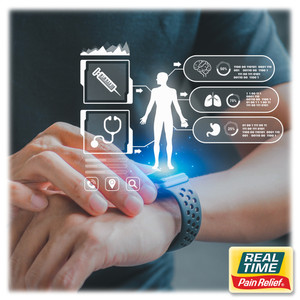5 Tips to Relieve Carpal Tunnel Syndrome
8th Mar 2023
Dealing with Carpal Tunnel Syndrome? Here are 5 tips to help you get relief!
Carpal tunnel syndrome is one of the most common conditions affecting the nerves. According to the American College of Rheumatology, it is estimated to affect up to 10 million people in the United States. Having the condition diagnosed properly is essential to getting the right treatment.
What is Carpal Tunnel Syndrome?
Carpal tunnel syndrome involves compression of a main nerve in the hand. The nerve runs through the carpal tunnel, which is a space or compartment located on the base of the hand.
The carpal tunnel houses the median nerve and the tendons that help move the fingers. The tendons in the carpal tunnel may become irritated from repetitive movements.
This irritation can lead to swelling, which narrows the tunnel, and squeezes or compresses the nerve.
Symptoms
Carpal tunnel pain can affect one or both hands. In most cases, symptoms start mildly and gradually increase over time. Common symptoms of carpal tunnel include the following:
- Numbness and tingling of the fingers
- Pain in the fingers or the hands
- Clumsiness of the hand, such as dropping things
- Electric shock sensation that radiates to the fingers or thumb
Risk Factors
Anyone can develop carpal tunnel syndrome, however,the condition tends to occur more often in women. According to the National Institute of Neurological Disorders and Stroke, women develop carpal tunnel pain about three times as often as men. The exact reason is not clear. ne theory is that the space, or carpal tunnel, is smaller in women, meaning it may be easier for the nerve to become compressed.
Additional risk factors include:
- Having an inflammatory disease, such as rheumatoid arthritis
- Conditions that damage the nerves, such as diabetes
- Trauma to the wrist
- Repetitive motions involving the wrist
5 Relief Tips for Carpal Tunnel Pain
If you have symptoms associated with carpal tunnel syndrome, it’s best to see a doctor to get an accurate diagnosis. Depending on the severity of symptoms and how much the syndrome is interfering with day to day activities, home treatment may be the first step.
The tips below may provide relief from the pain of carpal tunnel syndrome.
#1) Consider Wearing a Splint:
A splint may be recommended, especially at night. Wearing a splint while you sleep may help keep your wrist in a neutral position, which decreases pressure on the median nerve. Reducing pressure on the nerve may ease discomfort in the morning. For those that do certain types of work, such as using a computer for several hours a day, a splint may also be helpful to keep the wrist straight and decrease pressure. Your wrist should be in alignment with your fingers and not flexed or bent when using the mouse or keyboard.
#2) Take Breaks from Activities That Stress the Hands:
If you do certain types of jobs that involve repetitive movements with your wrists, or if you use power tools, frequently stop to stretch your hands and give your wrists a break.. If possible, consider modifying certain work activities. For example, voice activation software may be an option when using a computer to cut down on typing.
#3) Take a Joint Supplement:
Keeping the joints of the wrist healthy is helpful to prevent additional problems. Although carpal tunnel involves the nerves, it can occur along with joint conditions such as osteoarthritis. It may also develop as a result of rheumatoid arthritis. A joint supplement with natural ingredients, such as ginger root and turmeric, can help combat inflammation that is leading to compression of the nerve.
#4) Learn Tendon Gliding Exercises:
Tendon gliding exercises may be helpful in treating carpal tunnel syndrome. Certain exercises that stretch the wrist may also be beneficial. It’s best to ask your doctor to show you specific exercises for carpal tunnel syndrome to make sure you are doing them correctly.
#5) Apply Pain Relief Lotion:
Topical pain relief lotions can be an effective way to decrease pain associated with carpal tunnel syndrome, and they have fewer possible side effects than pills. Look for pain relief lotions containing active ingredients like menthol, trolamine salicylate, and arnica. Some great inactive ingredients in topical pain relief lotions include: calendula, hemp oil, turmeric, MSM, helichrysum, and more.
If conservative treatment does not provide relief for carpal tunnel syndrome, additional treatments may be helpful. Carpal tunnel syndrome may also be treated with cortisone injections or surgery.
Prevention of Carpal Tunnel Syndrome
As with all medical conditions, prevention is always the best bet. It may not always be possible to prevent carpal tunnel syndrome, but there are things you can do that might reduce your risk.
Consider the following tips:
- Maintain good form when using a computer to prevent added pressure on the wrists.
- Do not grip items too tightly.
- Take frequent breaks from activities that involve the wrist, such as using a keyboard.
- Gently stretch the hands and wrist daily for a few minutes.
Deal with pain during your airplane travel? Here are some tips to help!
Have you heard of pain relieving bath bombs? Here are 7 reasons you will love them!
Check out these 3 reasons to use a menthol based product the next time you're in pain!
Check out our blog to learn a multitude of ways to start relieving your pain naturally!
Real Time Pain Relief not only cares about the quality ingredients that go into each and every one of our products – but also about the people who buy them. We hope this blog becomes a valued resource for your own personal journey to better health. For 20 years, Real Time Pain Relief has provided family safe pain relief infused with Nature’s Ingredients. From the useful information in our articles to our high-quality products, we hope you feel better and pass it on!
Sources





